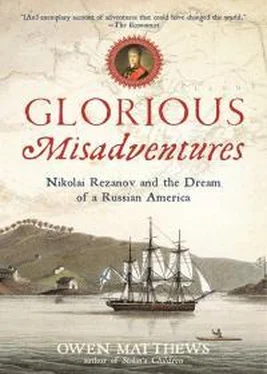* Thanks to global warming, the north-east passage has since 2008 become navigable (with the help of icebreakers) for enough of the year to make it a commercially viable shipping lane.
3
The Court
I am a Tsar – I am a slave,
I am a worm – I am a God . . .
Gavriil Derzhavin, ‘Ode to God’, 1784
For the Russian aristocracy the court was the centre of the world: it was the source of all power and patronage, gossip and scandal, disgrace and ruin. The sovereign’s favour could raise ambitious men like Catherine the Great’s lovers Grigory Orlov and Grigory Potemkin to the heights of wealth and power. Catherine may have corresponded with François-Marie d’Arouet Voltaire and Denis Diderot about enlightened ideas for ruling Russia, but in reality her court was as unpredictable, Asiatic and dependent on the caprice of the monarch as Ivan the Terrible’s had been two centuries before. The glittering reception halls of the Winter Palace were a giant casino of fortune, and the two thousand wax candles that burned every interminable St Petersburg night on the palace’s chandeliers illuminated an elegant game of risk which the milling men and women below were playing for their lives.
From a tender age the young Nikolai Rezanov was put to work cultivating powerful patrons. The Russians, like the eighteenth-century English, called it ‘interest’ – the network of connections without which no job could be lobbied or career made. Noble rank alone was no guarantee of advancement. The Russian monarchy may have been the most absolute in Europe – peasants were expected to prostrate themselves flat on the ground as the imperial carriage passed by – yet Russian society was surprisingly upwardly mobile.1 This was partly the legacy of Peter the Great, who had gone out of his way to break the power of the Moscow boyars by promoting both foreigners and humble men such as his favourite Prince Alexander Menshikov, a former pie vendor, to greatness. Tsar Peter himself married a buxom peasant girl from Livonia who succeeded him as the Empress Catherine I.
The prevalence of self-made men – or rather, tsar-made men – in the upper ranks of Russian society was a sign not of any democratic instinct but rather the desire of the tsars to surround themselves with their own protégés. Aristocrats with inherited wealth and connections could have complex and shifting loyalties. Foreigners or Russian men of no rank owed their advancement solely to the favour of their monarch. They were therefore their sovereign’s creatures, and his or her most obedient lieutenants. As a result the court history of eighteenth-century Russia is full of talented parvenus and pampered lover-favourites. Gavriil Derzhavin, a poor nobleman who rose to the highest posts in the state, was the archetypal brilliant upstart and was to play a vital role in the life of young Nikolai Rezanov. Derzhavin was from an impoverished gentry family from Kazan who were, like the Rezanovs, of Tatar origin. Derzhavin had made his way to the capital as a teenager and joined the Preobrazhensky Guards as a private, not being able to afford to buy an officer’s commission. He quickly rose through the ranks. The young Derzhavin was befriended by Nikolai Rezanov’s uncle Ivan, who was himself busy hustling his way upwards through the Foreign Ministry.
Derzhavin’s breakthrough came in 1773 when a peasant named Emiliyan Pugachev raised the standard of revolt on the eastern borderlands of the empire. Claiming to be Catherine’s murdered husband Peter III, Pugachev and his army of Cossacks and outlaws moved west, burning noble estates and hanging all army officers they captured. In 1774, when the rebels took Kazan, Catherine grew seriously alarmed and sent the full might of her forces against the rebels. Derzhavin, serving under General Alexander Bibikov, was one of the young officers to emerge with glory. He also showed the poetic prowess which was to make him remembered as one of the greatest poets of pre-Pushkin Russia, penning his ‘Ode on the Death of General Bibikov’ after his chief died of typhus while pursuing the rebels across the Orenburg steppes.
Certainly by 1775, after Pugachev had been brought to Moscow in a cage and publicly executed, it was clear that Major General Derzhavin was a coming man. That year the eleven-year-old Nikolai Rezanov wrote to Derzhavin in a neat copperplate hand, addressing his uncle Ivan’s influential friend in his best schoolboy German. ‘ Mein Herr! That you condescend to take an interest in my fate I am most humbly grateful,’ wrote the boy. ‘I have heard from my mother that you wish to take me from the Izmailovsky Guards to the Preobrazhensky Guards under your patronage, for which consideration I am most delighted.’2 Rezanov had been put down for his grandfather’s regiment – the Izmailovsky – as an infant. Whether this mention of a transfer to Derzhavin’s Preobrazhensky Guards was a tactful request or thanks for an offer already made isn’t clear. In any case, though Derzhavin remained Rezanov’s patron and friend for life, the change of regiment never happened. In the late summer of 1778, at the age of fourteen and a half, Officer Cadet Rezanov joined the Izmailovsky Guards after all.
The guards regiments of the Russian army were modelled, socially as well as militarily, on their Western European prototypes. Most socially prestigious were the three Life Guard regiments created by Peter the Great, who named them after the ‘toy armies’ of boys he had recruited as a teenager from villages around his father’s palace outside Moscow – Izmailovo, Preobrazhenskoye and Semyonovskoye. Guards officers were drawn largely, but not exclusively, from the nobility. In any case, thanks to Peter’s table of ranks, all officers above the rank of captain became hereditary nobles ex officio. When Rezanov joined the Izmailovsky Guards his regiment was officered by the empire’s top people. The commanding officer was General Prince Nikolai Repnin, while its recently formed cadet corps was commanded by Major Prince Golitsyn. Among his fellow cadets was Alexander Alexandrovich Bibikov, son of the regiment’s former commander who had died putting down Pugachev’s revolt. Rezanov’s generation of cadets would go on to command the Russian army during the war against Napoleon in 1812.*
Unfortunately, young Rezanov soon found that he had been born at exactly the wrong moment for a glittering military career – just like his father before him. Early in her reign the Empress Catherine had set to projecting Russian naval power across the Mediterranean. A brilliant victory over the Ottoman navy by a newly built Russian fleet in the Turkish port of Cesme in 1770 astonished Europe. A series of land campaigns in the Balkans followed, eventually forcing the Sultan to cede swathes of modern Moldavia and Ukraine to Russia in 1774. That same year the suppression of Pugachev’s revolt also provided opportunities for military glory – and the massacre of superior officers necessary for the promotion of ambitious young subalterns. But all this was no good for Rezanov, who had the misfortune to join the army right at the beginning of what was to be a fourteen-year outbreak of peace.
Every year, from 1 May to 1 September, the Izmailovsky Guards would take part in manoeuvres in the countryside around St Petersburg, tramping the roads of the Baltic coast in their green uniforms with red cuffs and collar, red waistcoat and breeches. In the winter the men retired to their log barracks at the regimental headquarters in the village of Kalininskoye, south of the capital, while the officers repaired to the city for the winter social season. This leisurely rhythm was doubtless a well-earned rest for the veteran senior officers, but for their ambitious juniors it must have been a tragic bore. The official regimental history is a perfect blank from the regiment’s return from putting down Pugachev in 1774 to the start of Catherine’s war against the Swedes in 1788.3
Читать дальше












